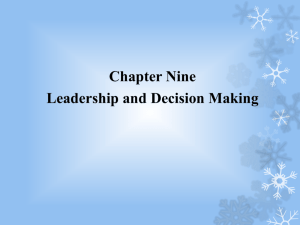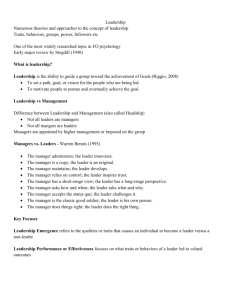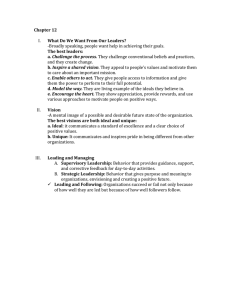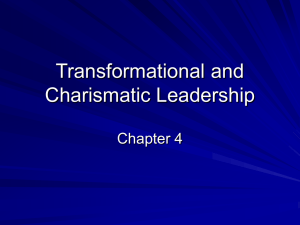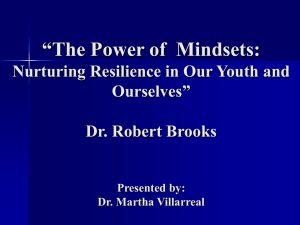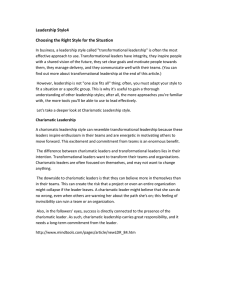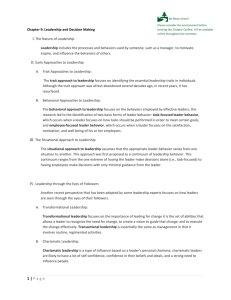Leadership and Decision Making
advertisement
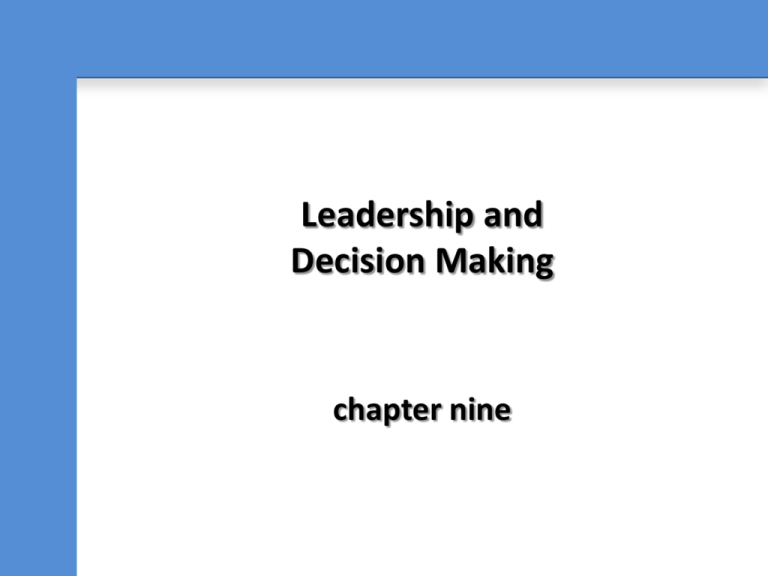
Leadership and Decision Making chapter nine Major Topics: 1. What is leadership and distinguish it from management. 2. Some early approaches to the study of leadership. 3. Situational approaches to leadership. 4. Describe transformational and charismatic perspectives on leadership. 9-2 Major Topics: 5. Identify and discuss leadership substitutes and neutralizers. 6. Discuss leaders as coaches and examine gender and cross-cultural issues in leadership. 7. Describe strategic leadership, ethical leadership, and virtual leadership. 8. Relate leadership to decision making and discuss both rational and behavioral perspectives on decision making. 9-3 The Nature of Leadership Leadership └ the processes and behaviors used by someone, such as a manager, to motivate, inspire, and influence the behaviors of others List 3 people you know that portray “Leadership” └ What about them makes them a “Leader” 9-4 Distinctions Between Management and Leadership A person can be a manager, a leader, both, or neither. 9-5 Early Approaches to Leadership Trait Approach to Leadership └ focused on identifying the essential traits that distinguished leaders • Abraham Lincoln ……. Could see the forest through all the trees…. └ intelligence, dominance, self-confidence, energy, activity (versus passivity), and knowledge about the job 9-6 Early Approaches to Leadership Behavioral Approach to Leadership └ focused on determining what behaviors are employed by leaders Task-Focused Leader Behavior └ leader behavior focusing on how tasks should be performed in order to meet certain goals and to achieve certain performance standards • Employee-Focused Leader Behavior └ leader behavior focusing on satisfaction, motivation, and wellbeing of employees Workers could have poor performance, but be satisfied, or vice verse 9-7 The Situational Approach to Leadership Situational Approach to Leadership └ assumes that appropriate leader behavior varies from one situation to another i.e., different types of leaders for the specific situation at hand Situational characteristics that affect decision making include the type of organization, group effectiveness, the problem itself, and time pressures 9-8 Leadership Through the Eyes of Followers Transformational Leadership └ the set of abilities that allows a leader to recognize the need for change, to create a vision to guide that change, and to execute the change effectively Transactional Leadership └ comparable to management, it involves routine, regimented activities 9-9 Leadership Through the Eyes of Followers Charisma └ a form of interpersonal attraction that inspires support and acceptance. Charismatic Leadership └ type of influence based on the leader’s personal charisma Can go both ways, e.g., Adolf Hitler, Enron, etc. 9-10 Crucial Elements of Charismatic Leadership 1. Charismatic leaders envision likely future trends and patterns, set high expectations for themselves and for others, and behave in ways that meet or exceed those expectations. 2. Charismatic leaders energize others by demonstrating personal excitement, personal confidence, and consistent patterns of success. 3. Charismatic leaders enable others by supporting them, empathizing with them, and expressing confidence in them. 9-11 Special Issues in Leadership Leadership Substitutes └ individual, task, and organizational characteristics that tend to outweigh the need for a leader to initiate or direct employee performance └ Book example of the ER Room at a hospital Leadership Neutralizers └ factors that may render leader behaviors ineffective └ Group Norms, … e.g., Firestone and MBA managers 9-12 The Changing Nature of Leadership Leaders as Coaches └ from directive overseer to mentor └ Why is this happening more today……???? Gender and Leadership └ understanding the differences and dynamics in the approaches of women and men to leadership 9-13 The Changing Nature of Leadership Cross-Cultural Leadership └ effects of an individual’s native culture on his or her approach to leadership when functioning in another culture └ Can be domestic culture as well as international 9-14 Emerging Issues in Leadership Strategic Leadership └ leader’s ability to understand the complexities of both the organization and its environment and to lead change in the organization so as to enhance its competitiveness 9-15 Emerging Issues in Leadership Ethical Leadership └ leader behaviors that reflect high ethical standards └ hold others in the organization to the same standards Virtual leadership └ leadership in settings where leaders and followers interact electronically rather than in face-to-face settings └ Instructor’s Caribbean and Latin American Situation └ face-to-face 3-days per 9-16 quarter… Leadership, Management, and Decision Making Decision Making └ choosing one alternative from among several options 9-17 Rational Decision Making Recognizing and defining the decision situation Identifying alternatives Evaluating alternatives Selecting the best alternative Implementing the chosen alternative Following up and evaluating the results 9-18 Behavioral Aspects of Decision Making Coalition └ an informal alliance of individuals or groups formed to achieve a common goal Intuition └ an innate belief about something, often without conscious consideration Politics, Boards, Stockholders, etc. 9-19 Behavioral Aspects of Decision Making Escalation of Commitment └ condition in which a decision maker becomes so committed to a course of action that she or he stays with it even when it appears to have been wrong • Corrected by Proper Management Controls (SUNK COSTS) • What happens if your leader is Hitler….. Risk Propensity └ extent to which a decision maker is willing to gamble when making a decision 9-20
